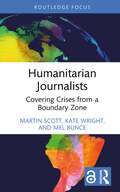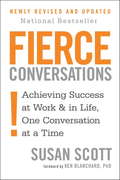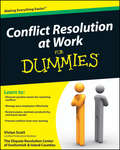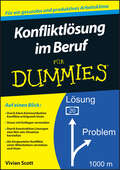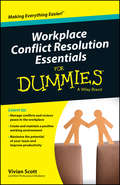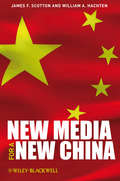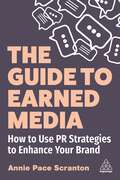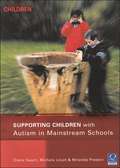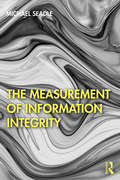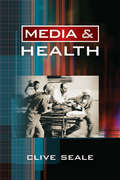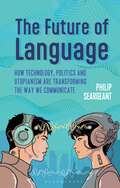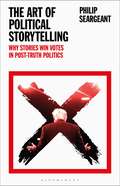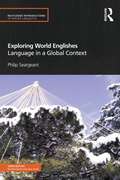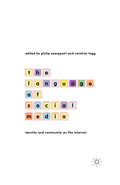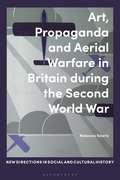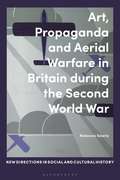- Table View
- List View
Humanitarian Journalists: Covering Crises from a Boundary Zone (Routledge Focus on Journalism Studies)
by Martin Scott Kate Wright Mel BunceThis book documents the unique reporting practices of humanitarian journalists – an influential group of journalists defying conventional approaches to covering humanitarian crises. Based on a 5-year study, involving over 150 in-depth interviews, this book examines the political, economic and social forces that sustain and influence humanitarian journalists. The authors argue that – by amplifying marginalised voices and providing critical, in-depth explanations of neglected crises – these journalists show us that another kind of humanitarian journalism is possible. However, the authors also reveal the heavy price these reporters pay for deviating from conventional journalistic norms. Their peripheral position at the ‘boundary zone’ between the journalistic and humanitarian fields means that a humanitarian journalist’s job is often precarious – with direct implications for their work, especially as ‘watchdogs’ for the aid sector. As a result, they urgently need more support if they are to continue to do this work and promote more effective and accountable humanitarian action. A rigorous study of how unique professional practices can be produced at the ‘boundary zone’ between fields, this book will interest students and scholars of journalism and communication studies, sociology and humanitarian studies. It will also appeal to those interested in studies of news and media work as occupational identities.
Humanitarian Journalists: Covering Crises from a Boundary Zone (Routledge Focus on Journalism Studies)
by Martin Scott Kate Wright Mel BunceThis book documents the unique reporting practices of humanitarian journalists – an influential group of journalists defying conventional approaches to covering humanitarian crises. Based on a 5-year study, involving over 150 in-depth interviews, this book examines the political, economic and social forces that sustain and influence humanitarian journalists. The authors argue that – by amplifying marginalised voices and providing critical, in-depth explanations of neglected crises – these journalists show us that another kind of humanitarian journalism is possible. However, the authors also reveal the heavy price these reporters pay for deviating from conventional journalistic norms. Their peripheral position at the ‘boundary zone’ between the journalistic and humanitarian fields means that a humanitarian journalist’s job is often precarious – with direct implications for their work, especially as ‘watchdogs’ for the aid sector. As a result, they urgently need more support if they are to continue to do this work and promote more effective and accountable humanitarian action. A rigorous study of how unique professional practices can be produced at the ‘boundary zone’ between fields, this book will interest students and scholars of journalism and communication studies, sociology and humanitarian studies. It will also appeal to those interested in studies of news and media work as occupational identities.
Fierce Conversations: Achieving success in work and in life, one conversation at a time
by Susan ScottFierce Conversations is a way of conducting business. An attitude. A way of life. Communications expert Susan Scott maintains that a single conversation can change the trajectory of a career, marriage or life. Whether these are conversations with yourself, partner, colleagues, customers, family or friends, Fierce Conversations shows you how to have conversations that count. Scott reveals how to:*Overcome the barriers to meaningful conversations*Express who you are and what you believe*Confront tough issues with courage, confidence and sensitivity*Overcome fear to get to the heart of the problem*Inspire followers, attract believers and build visions that become reality*Bring about real change through talking*Encourage others to reveal their true opinionsPacked with exercises and questionnaires to help you have the best conversations possible, Fierce Conversations will revolutionise the way you communicate.
Conflict Resolution at Work For Dummies
by Vivian ScottA practical workplace guide to handling conflict effectively Managing employees and encouraging them to work together toward a common goal is an essential skill that all leaders should possess. Conflict Resolution at Work For Dummies provides the tools and advice you need to restore peace, train your colleagues to get along better with others, prevent conflicts from ever starting, and maintain better productivity while boosting morale. One of the only trade publications that takes the manager's perspective on how to address conflicts, resolve disputes, and restore peace and productivity to the workplace Examines more positive means for resolving conflicts (other than arguing, surrendering, running away, filing a lawsuit, etc.) Helps managers and employees sort through problems and make the workplace a more rewarding place No manager should be without Conflict Resolution at Work For Dummies!
Conflict Resolution at Work For Dummies
by Vivian ScottA practical workplace guide to handling conflict effectively Managing employees and encouraging them to work together toward a common goal is an essential skill that all leaders should possess. Conflict Resolution at Work For Dummies provides the tools and advice you need to restore peace, train your colleagues to get along better with others, prevent conflicts from ever starting, and maintain better productivity while boosting morale. One of the only trade publications that takes the manager's perspective on how to address conflicts, resolve disputes, and restore peace and productivity to the workplace Examines more positive means for resolving conflicts (other than arguing, surrendering, running away, filing a lawsuit, etc.) Helps managers and employees sort through problems and make the workplace a more rewarding place No manager should be without Conflict Resolution at Work For Dummies!
Konfliktlösung im Beruf für Dummies (Für Dummies)
by Vivian ScottKonflikte erkennen, lösen oder von vornherein vermeiden Konflikte treten unweigerlich im Berufsleben auf – ob Sie anderer Meinung als Ihr Chef oder Ihre Mitarbeiter sind oder mit einem Kollegen aneinandergeraten. Dieses Buch gibt Hilfe zur Selbsthilfe bei der Lösung dieser Konflikte. Die Autorin zeigt, wie Sie Konflikte mit Ihren Kollegen oder als Vorgesetzter zwischen Mitarbeitern verstehen, entschärfen und im besten Fall lösen. Sie erfahren, wie Sie sich selbst und andere bewusst wahrnehmen, klar kommunizieren und im Gespräch auf die Bedürfnisse Ihres Gegenübers eingehen. So finden Sie Lösungen, die die Belange aller berücksichtigen. Sollte das nicht möglich sein, wird auch aufgezeigt, wie Sie Konflikte mit einem Mediator lösen können.
Workplace Conflict Resolution Essentials For Dummies (For Dummies)
by Vivian ScottResolving conflict in the workplace? No problem! Working your way through a conflict in the office can present unexpected challenges, but there's no need to feel unprepared — Workplace Conflict Resolution Essentials For Dummies has you covered! In the book, you'll find practical, expert guidance on various approaches to negotiating and mediating a successful resolution for you and your team. You'll get coverage of negotiation techniques, mediation methods and solutions for managers and employees dealing with workplace conflict, and tons of tips on building and maintaining successful teams to work through existing conflicts and help avoid future disturbances. Encouraging colleagues to work together toward a common goal is an essential skill that all successful business professionals must possess. Rather than resorting to arguments, surrendering, running away or filing a complaint, this resource shows you how to address uncomfortable conflict in the workplace head-on, giving you the tools and advice you need to restore peace, prevent conflicts from ever starting in the first place, and maintain better productivity while boosting morale. Offers clear instruction for addressing conflicts, resolving disputes and restoring peace and productivity to the workplace Helps you find a solution and explore positive means for resolving conflicts Illustrates how working through problems within your team makes the workplace the positive environment it should be Provides guidance on developing the key negotiation and mediation skills you need to create a harmonious workplace Whether you're new to managing professionals, working your way up the corporate ladder or just want to brush up on your knowledge base, Workplace Conflict Resolution Essentials For Dummies has everything you need to ensure your workplace environment is positive and productive!
Workplace Conflict Resolution Essentials For Dummies
by Vivian ScottResolving conflict in the workplace? No problem! Working your way through a conflict in the office can present unexpected challenges, but there's no need to feel unprepared — Workplace Conflict Resolution Essentials For Dummies has you covered! In the book, you'll find practical, expert guidance on various approaches to negotiating and mediating a successful resolution for you and your team. You'll get coverage of negotiation techniques, mediation methods and solutions for managers and employees dealing with workplace conflict, and tons of tips on building and maintaining successful teams to work through existing conflicts and help avoid future disturbances. Encouraging colleagues to work together toward a common goal is an essential skill that all successful business professionals must possess. Rather than resorting to arguments, surrendering, running away or filing a complaint, this resource shows you how to address uncomfortable conflict in the workplace head-on, giving you the tools and advice you need to restore peace, prevent conflicts from ever starting in the first place, and maintain better productivity while boosting morale. Offers clear instruction for addressing conflicts, resolving disputes and restoring peace and productivity to the workplace Helps you find a solution and explore positive means for resolving conflicts Illustrates how working through problems within your team makes the workplace the positive environment it should be Provides guidance on developing the key negotiation and mediation skills you need to create a harmonious workplace Whether you're new to managing professionals, working your way up the corporate ladder or just want to brush up on your knowledge base, Workplace Conflict Resolution Essentials For Dummies has everything you need to ensure your workplace environment is positive and productive!
New Media for a New China
by James F. Scotton William A. HachtenNew Media for a New China is a timely introduction to the current state of the mass media in China and it’s growing role in the 21st Century global communication system Brings together an international cast of scholars to analyse the diverse roles of China’s media, covering all the major industries (advertising, newspapers, broadcasting, magazines, film, TV, PR) Considers the position of China’s media in the middle of the country’s tremendous social, economic and political changes Explores the concept of the 21st century as “China’s Century” because of the nation’s unprecedented growth
The Guide to Earned Media: How to Use PR Strategies to Enhance Your Brand
by Annie Pace ScrantonHarness the power of public relations and discover how you can secure meaningful press for your organization.It can be difficult to publicize a company or a product without formal training, yet it's more important than ever for successful marketing strategies to include media relations. In this book, media expert Annie Pace Scranton breaks down the most powerful and efficient PR tactics that brands can use to garner the right kind of attention. The book guides marketing and PR professionals through the process of developing authentic messaging, unique selling points, timely news pitches and other engaging ways to reach the media.The Guide to Earned Media is a must-read for anyone ready to unleash the power of public relations, perfect their messaging and work toward long-term brand prominence. Readers will walk away knowing how to make use of the most effective media strategies available today.
The Guide to Earned Media: How to Use PR Strategies to Enhance Your Brand
by Annie Pace ScrantonHarness the power of public relations and discover how you can secure meaningful press for your organization.It can be difficult to publicize a company or a product without formal training, yet it's more important than ever for successful marketing strategies to include media relations. In this book, media expert Annie Pace Scranton breaks down the most powerful and efficient PR tactics that brands can use to garner the right kind of attention. The book guides marketing and PR professionals through the process of developing authentic messaging, unique selling points, timely news pitches and other engaging ways to reach the media.The Guide to Earned Media is a must-read for anyone ready to unleash the power of public relations, perfect their messaging and work toward long-term brand prominence. Readers will walk away knowing how to make use of the most effective media strategies available today.
Supporting Children with Autism in Mainstream Schools (Supporting Children)
by Diana Seach Michele Lloyd Miranda PrestonIt is increasingly common for children with autism to attend mainstream schools. In this book, the authors use their expertise and considerable experience of working with and observing pupils with autism to exemplify the challenges faced in the classroom. Most importantly, they suggest practical strategies for successfully meeting pupil's learning needs. The case studies bring to life the everyday concerns of young people, their parents and teachers, and provide different contexts for the demonstration of good practice.
The Measurement of Information Integrity
by Michael SeadleArguing that there never was a time when politicians did not prevaricate and when some communities did not doubt conclusions that others considered to be facts, The Measurement of Information Integrity puts the post-truth era in context and offers measures for integrity in the modern world. Incorporating international examples from a range of disciplines, this book provides the reader with tools that will help them to evaluate public statements - especially ones involving the sciences and scholarship. It also provides intellectual tools to those who must assess potential violations of public or academic integrity. Many of these tools involve measurement mechanisms, ways of putting cases into context, and a recognition that few cases are simple black-and-white violations. Demonstrating that a binary approach to judging research integrity fails to recognize the complexity of the environment, Seadle highlights that even flawed discoveries may still contain value. Finally, the book reminds its reader that research integrity takes different forms in different disciplines and that each one needs separate consideration, even if the general principles remain the same for all. The Measurement of Information Integrity will help those who want to do research well, as well as those who must ascertain whether results have failed to meet the standards of the community. It will be of particular interest to researchers and students engaged in the study of library and information science.
The Measurement of Information Integrity
by Michael SeadleArguing that there never was a time when politicians did not prevaricate and when some communities did not doubt conclusions that others considered to be facts, The Measurement of Information Integrity puts the post-truth era in context and offers measures for integrity in the modern world. Incorporating international examples from a range of disciplines, this book provides the reader with tools that will help them to evaluate public statements - especially ones involving the sciences and scholarship. It also provides intellectual tools to those who must assess potential violations of public or academic integrity. Many of these tools involve measurement mechanisms, ways of putting cases into context, and a recognition that few cases are simple black-and-white violations. Demonstrating that a binary approach to judging research integrity fails to recognize the complexity of the environment, Seadle highlights that even flawed discoveries may still contain value. Finally, the book reminds its reader that research integrity takes different forms in different disciplines and that each one needs separate consideration, even if the general principles remain the same for all. The Measurement of Information Integrity will help those who want to do research well, as well as those who must ascertain whether results have failed to meet the standards of the community. It will be of particular interest to researchers and students engaged in the study of library and information science.
Media and Health
by Clive Seale`This book appears to fill a substantial gap in the literature at present. There are, quite simply, no books available which engage seriously and competently with the presentation of health issues in the media, and certainly none which focuses on representations of health and illness in as thematically coherent a manner as Seale proposes to do' - Richard Gwyn, University of Cardiff `This is an excellent resource for students. It provides a comprehensive review of secondary literature in the field and is very well researched. Students of sociology of health and illness and in media and communication studies will find the book invaluable' - David Oswell, Goldsmiths College, University of London `This is a comprehensive work on media health, providing an invaluable "toolkit" for understanding health and the media in contemporary society. Seale goes further than previous textbooks, critiquing the "lament" of media health promoters in order to explore the moralisation and commercialisation of media health' - Dr Annette Hill, University of Westminster How are health matters presented by the mass media? How accurate are the messages we are receiving? This book demonstrates how health messages in popular mass media are important influences in our lives, and that they are not neutral, being subject to many determining influences. It demonstrates the importance of mass media for understanding the experience of illness, health and health care, bringing together the latest thinking in the field of media studies and the sociology of health and illness. This book provides a thorough review of research literature on media representations of health, illness and health care, covering their production, characteristic forms and relationships with the everyday lives of media audiences. It brings together both well known and lesser-known studies in the context of an integrated, sociological argument about media and health. Media producers are subject to a variety of influences, from medical lobbies, scientific organizations, and not least the commercial pressure to satisfy media-saturated audiences. These mean that aims of health promoters are not always easily achieved, leading to considerable tensions that require a deeper understanding of media health than has hitherto been applied to them. This book will be essential reading for health educators and promoters, as well as health care providers interested in the cultural aspects of health, sociologists of health and illness, and students and academics of media studies.
Media and Health (PDF)
by Clive Seale`This book appears to fill a substantial gap in the literature at present. There are, quite simply, no books available which engage seriously and competently with the presentation of health issues in the media, and certainly none which focuses on representations of health and illness in as thematically coherent a manner as Seale proposes to do' - Richard Gwyn, University of Cardiff `This is an excellent resource for students. It provides a comprehensive review of secondary literature in the field and is very well researched. Students of sociology of health and illness and in media and communication studies will find the book invaluable' - David Oswell, Goldsmiths College, University of London `This is a comprehensive work on media health, providing an invaluable "toolkit" for understanding health and the media in contemporary society. Seale goes further than previous textbooks, critiquing the "lament" of media health promoters in order to explore the moralisation and commercialisation of media health' - Dr Annette Hill, University of Westminster How are health matters presented by the mass media? How accurate are the messages we are receiving? This book demonstrates how health messages in popular mass media are important influences in our lives, and that they are not neutral, being subject to many determining influences. It demonstrates the importance of mass media for understanding the experience of illness, health and health care, bringing together the latest thinking in the field of media studies and the sociology of health and illness. This book provides a thorough review of research literature on media representations of health, illness and health care, covering their production, characteristic forms and relationships with the everyday lives of media audiences. It brings together both well known and lesser-known studies in the context of an integrated, sociological argument about media and health. Media producers are subject to a variety of influences, from medical lobbies, scientific organizations, and not least the commercial pressure to satisfy media-saturated audiences. These mean that aims of health promoters are not always easily achieved, leading to considerable tensions that require a deeper understanding of media health than has hitherto been applied to them. This book will be essential reading for health educators and promoters, as well as health care providers interested in the cultural aspects of health, sociologists of health and illness, and students and academics of media studies.
The Future of Language: How Technology, Politics and Utopianism are Transforming the Way we Communicate
by Dr Philip SeargeantWill language as we know it cease to exist? What could this mean for the way we live our lives?Shining a light on the technology currently being developed to revolutionise communication, The Future of Language distinguishes myth from reality and superstition from scientifically-based prediction as it plots out the importance of language and raises questions about its future. From the rise of artificial intelligence and speaking robots, to brain implants andcomputer-facilitated telepathy, language and communications expert Philip Seargeant surveys the development of new digital 'languages', such as emojis, animated gifs and memes, and investigates how conventions of spoken and written language are being modified by new trends in communication. From George Orwell's fictional predictions in Nineteen Eighty-Four to the very real warnings of climate activist Greta Thunberg, Seargeant explores language through time, traversing politics, religion, philosophy, literature, and of course technology, in the process. Tracing how previous eras have imagined the future of language, from the Bible to the works H. G. Wells, and from Star Wars to Star Trek, the book reveals how perfecting language and communication has always been a vital component of utopian dreams of the future. Questioning the potential ramifications of recent and future developments in communication on society and its ideals, The Future of Language is a no holds barred investigation into the state of civilisation and the impact that changes in language could have on our lives.
The Future of Language: How Technology, Politics and Utopianism are Transforming the Way we Communicate
by Dr Philip SeargeantWill language as we know it cease to exist? What could this mean for the way we live our lives?Shining a light on the technology currently being developed to revolutionise communication, The Future of Language distinguishes myth from reality and superstition from scientifically-based prediction as it plots out the importance of language and raises questions about its future. From the rise of artificial intelligence and speaking robots, to brain implants andcomputer-facilitated telepathy, language and communications expert Philip Seargeant surveys the development of new digital 'languages', such as emojis, animated gifs and memes, and investigates how conventions of spoken and written language are being modified by new trends in communication. From George Orwell's fictional predictions in Nineteen Eighty-Four to the very real warnings of climate activist Greta Thunberg, Seargeant explores language through time, traversing politics, religion, philosophy, literature, and of course technology, in the process. Tracing how previous eras have imagined the future of language, from the Bible to the works H. G. Wells, and from Star Wars to Star Trek, the book reveals how perfecting language and communication has always been a vital component of utopian dreams of the future. Questioning the potential ramifications of recent and future developments in communication on society and its ideals, The Future of Language is a no holds barred investigation into the state of civilisation and the impact that changes in language could have on our lives.
The Art of Political Storytelling: Why Stories Win Votes in Post-truth Politics
by Philip SeargeantIn our post-truth world, tapping into people's emotions has proved far more effective than rational argument - and, as Philip Seargeant argues in this illuminating and entertaining book, the most powerful tool for manipulating emotions is a gripping narrative. From Trump's America to Brexit Britain, weaving a good story, featuring fearless protagonists, challenging quests against seemingly insurmountable odds, and soundbite after soundbite of memorable dialogue has been at the heart of political success. So does an understanding of the art of storytelling help explain today's successful political movements? Can it translate into a blueprint for victory at the ballot box?The Art of Political Storytelling looks at how stories are created, shared and contested, illuminating the pivotal role that persuasive storytelling plays in shaping our understanding of the political world we live in. By mastering the tools and tricks of narrative, and evaluating the language and rhetorical strategies used to craft and enact them, Seargeant explains how and why today's combination of new media, populism and partisanship makes storytelling an ever more important part of the persuasive and political process. In doing so, the book offers an original and compelling way of understanding the chaotic world of today's politics.
The Art of Political Storytelling: Why Stories Win Votes in Post-truth Politics
by Philip SeargeantIn our post-truth world, tapping into people's emotions has proved far more effective than rational argument - and, as Philip Seargeant argues in this illuminating and entertaining book, the most powerful tool for manipulating emotions is a gripping narrative. From Trump's America to Brexit Britain, weaving a good story, featuring fearless protagonists, challenging quests against seemingly insurmountable odds, and soundbite after soundbite of memorable dialogue has been at the heart of political success. So does an understanding of the art of storytelling help explain today's successful political movements? Can it translate into a blueprint for victory at the ballot box?The Art of Political Storytelling looks at how stories are created, shared and contested, illuminating the pivotal role that persuasive storytelling plays in shaping our understanding of the political world we live in. By mastering the tools and tricks of narrative, and evaluating the language and rhetorical strategies used to craft and enact them, Seargeant explains how and why today's combination of new media, populism and partisanship makes storytelling an ever more important part of the persuasive and political process. In doing so, the book offers an original and compelling way of understanding the chaotic world of today's politics.
Exploring World Englishes: Language In A Global Context (PDF)
by Philip SeargeantRoutledge Introductions to Applied Linguisticsis a series of introductory level textbooks covering the core topics in Applied Linguistics, primarily designed for those beginning postgraduate studies, or taking an introductory MA course as well as advanced undergraduates. Titles in the series are also ideal for language professionals returning to academic study. The books take an innovative 'practice to theory' approach, with a 'back-to-front' structure. This leads the reader from real-world problems and issues, through a discussion of intervention and how to engage with these concerns, before finally relating these practical issues to theoretical foundations. Additional features include tasks with commentaries, a glossary of key terms, and an annotated further reading section. In this book Philip Seargeant surveys varieties of English existing within the world today, and the debates and controversies surrounding its present forms, functions and status in diverse world contexts. It examines how English has evolved to become a 'global language' and looks at the political and cultural history that has influenced this evolution. Beginning with a discussion of real-life challenges relating to world Englishes that are faced by language professionals - particularly in the contexts of language education and language planning - the book explores and illustrates the ways in which the actual use and management of English, as well as the beliefs and ideologies associated with it, play an increasingly important role in contemporary globalized society.
Exploring World Englishes: Language In A Global Context
by Philip SeargeantRoutledge Introductions to Applied Linguisticsis a series of introductory level textbooks covering the core topics in Applied Linguistics, primarily designed for those beginning postgraduate studies, or taking an introductory MA course as well as advanced undergraduates. Titles in the series are also ideal for language professionals returning to academic study. The books take an innovative 'practice to theory' approach, with a 'back-to-front' structure. This leads the reader from real-world problems and issues, through a discussion of intervention and how to engage with these concerns, before finally relating these practical issues to theoretical foundations. Additional features include tasks with commentaries, a glossary of key terms, and an annotated further reading section. In this book Philip Seargeant surveys varieties of English existing within the world today, and the debates and controversies surrounding its present forms, functions and status in diverse world contexts. It examines how English has evolved to become a 'global language' and looks at the political and cultural history that has influenced this evolution. Beginning with a discussion of real-life challenges relating to world Englishes that are faced by language professionals - particularly in the contexts of language education and language planning - the book explores and illustrates the ways in which the actual use and management of English, as well as the beliefs and ideologies associated with it, play an increasingly important role in contemporary globalized society.
The Language of Social Media: Identity and Community on the Internet
by Philip Seargeant Caroline TaggThis timely book examines language on social media sites including Facebook and Twitter. Studies from leading language researchers, and experts on social media, explore how social media is having an impact on how we relate to each other, the communities we live in, and the way we present a sense of self in twenty-first century society.
Art, Propaganda and Aerial Warfare in Britain during the Second World War (New Directions in Social and Cultural History)
by Rebecca SearleThe War Artists' Advisory Committee (WAAC) were responsible for the production of some of the most iconic images of the Second World War. Despite its rich historical value, this collection has been poorly utilised by historians and hasn't been subjected to the levels of analysis afforded to other forms of wartime culture. This innovative study addresses this gap by bringing official war art into dialogue with the social, economic and military histories of the Second World War. Rebecca Searle explores the tensions between the documentarist and propagandistic roles of the WAAC in their representation of aerial warfare in the battle for production, the Battle of Britain, the Blitz and the bombing of Germany. Her analyses demonstrate that whilst there was a strong correlation between war art and propaganda, the WAAC depicted many aspects of experience that were absent from wartime propaganda, such as class divisions within the services, gendered hierarchies within industries, civilian death and the true nature of the bombing of Germany. In addition, she shows that propagandistic constructions were not entirely separate from lived experience, but reflected experience and shaped the way that individuals made sense of the war. Accessibly written, highly illustrated and packed with valuable examples of the use of war art as historical source, this book will enhance our understanding of the social and cultural history of Britain during the Second World War.
Art, Propaganda and Aerial Warfare in Britain during the Second World War (New Directions in Social and Cultural History)
by Rebecca SearleThe War Artists' Advisory Committee (WAAC) were responsible for the production of some of the most iconic images of the Second World War. Despite its rich historical value, this collection has been poorly utilised by historians and hasn't been subjected to the levels of analysis afforded to other forms of wartime culture. This innovative study addresses this gap by bringing official war art into dialogue with the social, economic and military histories of the Second World War. Rebecca Searle explores the tensions between the documentarist and propagandistic roles of the WAAC in their representation of aerial warfare in the battle for production, the Battle of Britain, the Blitz and the bombing of Germany. Her analyses demonstrate that whilst there was a strong correlation between war art and propaganda, the WAAC depicted many aspects of experience that were absent from wartime propaganda, such as class divisions within the services, gendered hierarchies within industries, civilian death and the true nature of the bombing of Germany. In addition, she shows that propagandistic constructions were not entirely separate from lived experience, but reflected experience and shaped the way that individuals made sense of the war. Accessibly written, highly illustrated and packed with valuable examples of the use of war art as historical source, this book will enhance our understanding of the social and cultural history of Britain during the Second World War.
